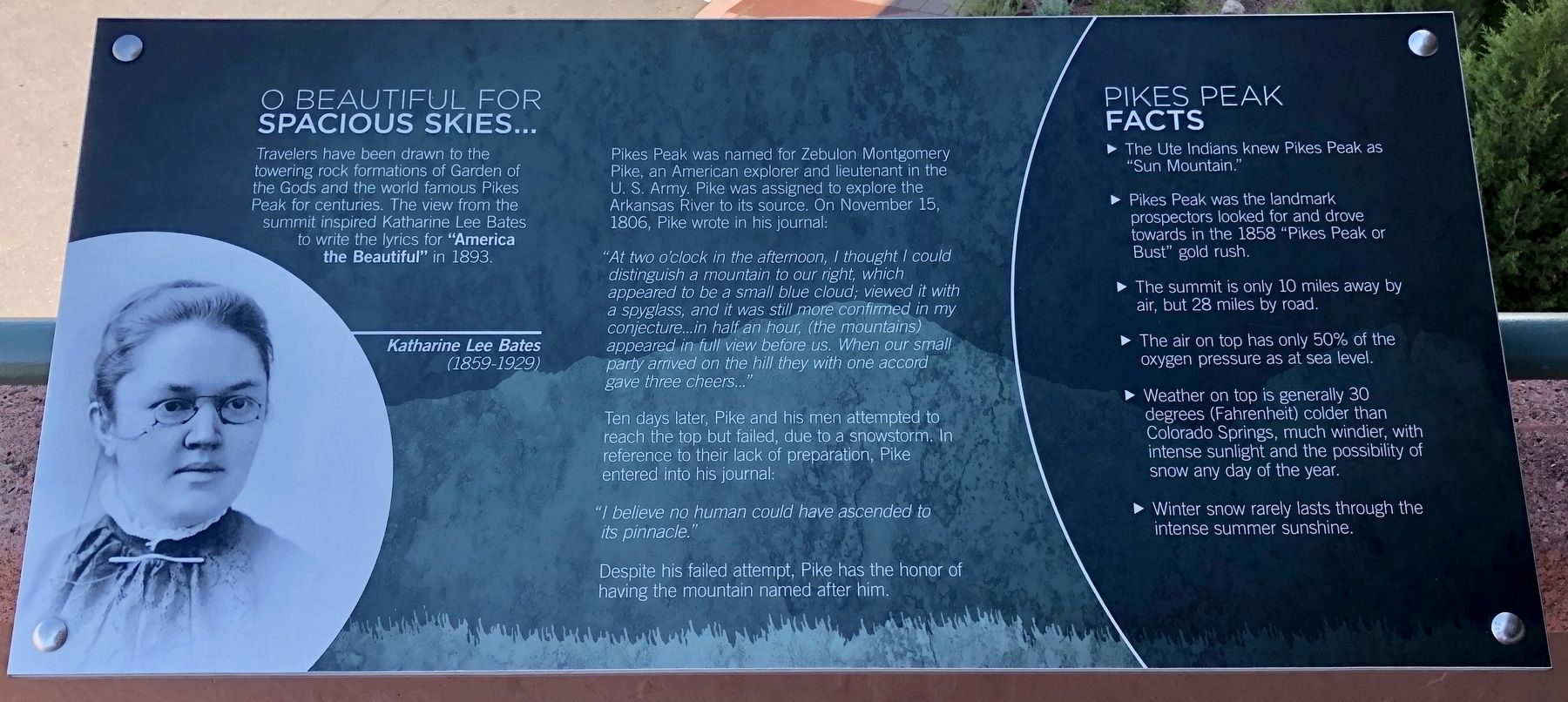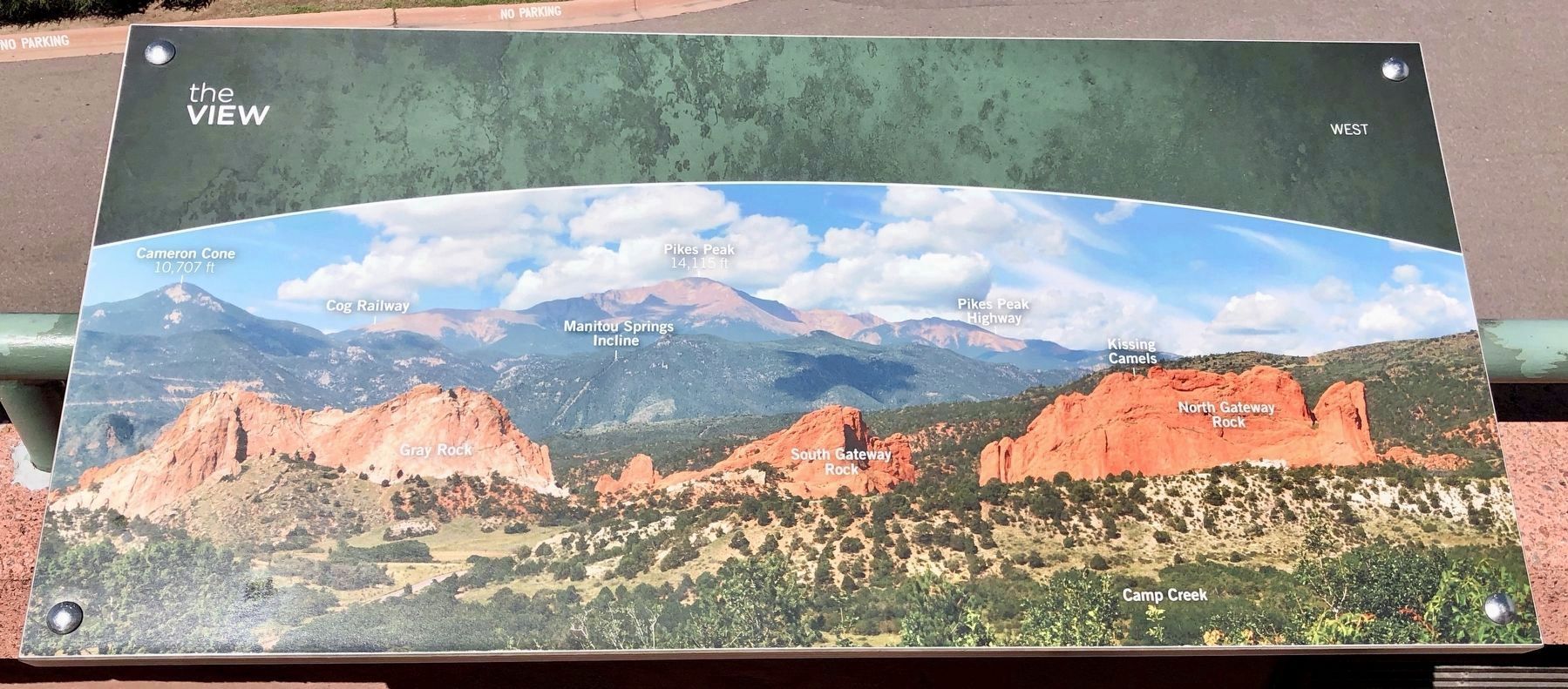West Colorado Springs in El Paso County, Colorado — The American Mountains (Southwest)
O Beautiful For Spacious Skies...
Pikes Peak was named for Zebulon Montgomery Pike, an American explorer and lieutenant in the U. S. Army. Pike was assigned to explore the Arkansas River to its source. On November 15, 1806, Pike wrote in his journal:
"At two o'clock in the afternoon, I thought I could distinguish a mountain to our right, which appeared to be a small blue cloud; viewed it with a spyglass, and it was still more confirmed in my conjecture...in half an hour, (the mountains) appeared in full view before us. When our small party arrived on the hill they with one accord gave three cheers..."
Ten days later, Pike and his men attempted to reach the top but failed, due to a snowstorm. In reference to their lack of preparation, Pike entered into his journal:
"I believe no human could have ascended to its pinnacle."
Despite his failed attempt, Pike has the honor of having the mountain named after him.
Pikes Peak Facts
♦The Ute Indians knew Pikes Peak as Sun Mountain."
♦Pikes Peak was the landmark prospectors looked for and drove towards in the 1858 "Pikes Peak or Bust" gold rush.
♦The summit is only 10 miles away by air, but 28 miles by road.
♦The air on top has only 50% of the oxygen pressure as at sea level.
♦Weather on top is generally 30 degrees (Fahrenheit) colder than Colorado Springs, much windier, with intense sunlight and the possibility of snow any day of the year.
♦Winter snow rarely lasts through the intense summer sunshine.
Topics. This historical marker is listed in these topic lists: Arts, Letters, Music • Exploration • Women. A significant historical date for this entry is November 15, 1806.
Location. 38° 52.699′ N, 104° 52.195′ W. Marker is in Colorado Springs, Colorado, in El Paso County. It is in West Colorado Springs. Marker can be reached from the intersection of North 30th Street and Gateway Road.. Located at the Garden of the Gods Visitors Center. Touch for map. Marker is at or near this postal address: 1805 North 30th Street, Colorado Springs CO 80904, United States of America. Touch for directions.
Other nearby markers. At least 8 other markers are within walking distance of this marker. Rock Ledge Ranch Historic Site (a few steps from this marker); Garden of the Gods Park (about 600 feet away, measured in a direct line); Bloomer Girl; A Colorado Trailblazer (about 600 feet away); a different marker also named Rock Ledge Ranch Historic Site (about 600 feet away); The Garden of the Gods (approx. 0.6 miles away); Welcome to Garden of the Gods Park (approx. 0.6 miles away); A Priceless Gift (approx. 0.6 miles away); Time Frozen In Stone (approx. 0.6 miles away). Touch for a list and map of all markers in Colorado Springs.
Also see . . .
1. Wikipedia article on Pikes Peak. Excerpt:
Pikes Peak is one of Colorado’s 54 fourteeners, mountains more than 14,000 feet above sea level. The massif rises 8,000 ft above downtown Colorado Springs. Pikes Peak is a designated National Historic Landmark. It is composed of a characteristic pink granite called Pikes Peak granite. The color is due to a large amount of potassium feldspar.(Submitted on June 21, 2019, by Mark Hilton of Montgomery, Alabama.)
2. Wikipedia article on Katharine Lee Bates. Excerpt:
The words to her famous poem first appeared in print in The Congregationalist, a weekly journal, for Independence Day, 1895. The poem reached a wider audience when her revised version was printed in the Boston Evening Transcript on November 19, 1904. Her final expanded version was written in 1913. When a version appeared in her collection America the Beautiful, and Other Poems (1912.(Submitted on June 21, 2019, by Mark Hilton of Montgomery, Alabama.)
3. “America the Beautiful” entry at the U.S. Library of Congress. Excerpt:
As [Katharine Lee Bates] told it, “"We strangers celebrated the close of the session by a merry expedition to the top of Pike’s Peak...It was then and there, as I was looking out over the sea-like expanse of fertile country spreading away so far under those ample skies, that the opening lines of the hymn floated into my mind.”(Submitted on November 6, 2021, by J. J. Prats of Powell, Ohio.)
For several years “America the Beautiful” was sung to almost any popular air or folk tune with which the lyrics fit... Today it is sung to a melody written in 1882 by Samuel Augustus Ward, a Newark, New Jersey, church organist and choirmaster.
4. “America the Beautiful” – U.S. Navy Band - 2019.
(Submitted on November 6, 2021.)
Credits. This page was last revised on February 7, 2023. It was originally submitted on June 21, 2019, by Mark Hilton of Montgomery, Alabama. This page has been viewed 455 times since then and 38 times this year. It was the Marker of the Week November 7, 2021. Photos: 1, 2, 3. submitted on June 21, 2019, by Mark Hilton of Montgomery, Alabama.

